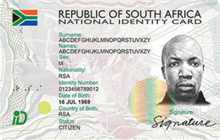South African identity card
The South African smart identity card – known as a Smart ID Card – replaces the old green bar-coded identity book.[1] Both are identity documents that serve as proof of a person's identity. This proof includes a person's photograph, their full name, their date of birth, their place of birth, and their unique identity number. South African identity documents also include evidence of votes cast in local and national elections, as a means to prevent voter fraud.
| South African Identity Card | |
|---|---|
 South African Smart Card (front) | |
 Reverse | |
| Type | Identity card |
| Issued by | |
| Purpose | Proof of identity |
| Valid in | |
| Eligibility | South African citizenship and birth within South Africa |
Identity documents are issued to South African citizens or permanent residence permit holders who are 15 years and six months or older. People, including spouses and children, who are working for the South African government or one of its statutory bodies outside of South Africa also qualify to receive a South African identity document.[1]
As of January 2020, South African citizens born outside of South Africa, as well as permanent residents, still cannot apply for the new ID card, nor access the online services of Home Affairs.
Identity documents are issued by South Africa's National Department of Home Affairs.[2]
How South Africans can apply for a Smart ID Card
Only South African citizens born in South Africa may apply for the Smart ID card. The card is not available to South African citizens born outside of South Africa, or South African permanent residents, who need to apply instead for the old green ID book.
South African citizens born in South Africa can apply for a smart ID card in two ways: they can either apply at their local home affairs,[3] or they can apply online[4] at the Home Affairs e-Channel website.
The website provides a step-by-step guide on how to apply.[5]
People in South Africa who need help with applying for their smart ID card can call the Department of Home Affairs contact centre on +27800 601 190.[6]
History
Information provided
- Surname
- First name(s)
- Sex
- Nationality
- Identity number
- Date of birth
- Country of birth
- South African citizenship status (citizen or permanent resident)
- Primary image on front of card, secondary image on back of card
- Signature
Identity Number
Each South African ID number is a 13 digit number defined as YYMMDD SSSS CAZ, which deciphers as follows:
| Field | Description |
|---|---|
| YYMMDD | Date of birth |
| SSSS | Sequential number: 0000–4999 for females and 5000–9999 for males. |
| C | Status: 0 = South African citizen, 1 = non-SA-born permanent resident. |
| A | 8 or 9 |
| Z | Check digit used to validate the ID Number, which is calculated using the Luhn algorithm. |
Barcode Data
The back of the card contains two barcodes:
PDF417
The two-dimensional PDF417 barcode contains:
- Surname
- Names
- Sex
- Nationality
- Identity Number
- Day of Birth
- Country of Birth
- Status
- Date of Issue
- A 5 digit unidentified hidden number not appearing on the card
- A 9 digit unlabelled number appearing on the back of the card
- The sequence 1234567890 repeated to fill up the available space in the PDF417 barcode.
See also
- National identity cards
References
- Department of Home Affairs, Know your new Smart ID Card
- Department of Home Affairs, Identity documents
- "Department of Home Affairs - Identity Documents". www.dha.gov.za. Retrieved 2017-11-23.
- "Department of Home Affairs - HOME". www.dha.gov.za. Retrieved 2017-11-23.
- "Get your Smart ID cards from these bank branches". Retrieved 2017-11-23.
- "Home Affairs - eHomeAffairs". ehome.dha.gov.za. Retrieved 2017-11-23.
- "Apply for a South African Smart ID Card - How-To Guide" (PDF). Department of Home Affairs. Retrieved 24 November 2017.
- "Contact Us". ehome.dha.gov.za. Retrieved 2017-11-23.